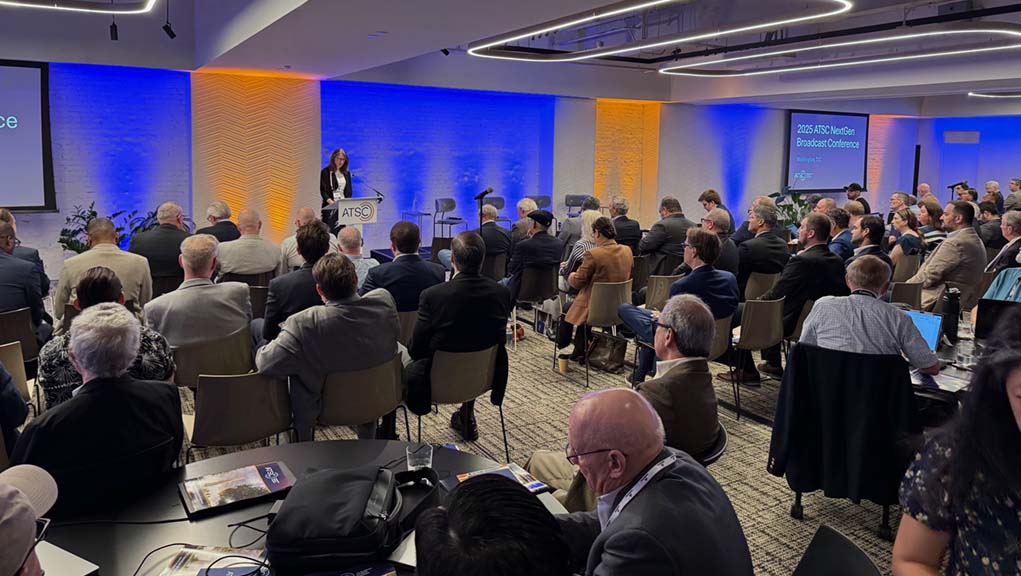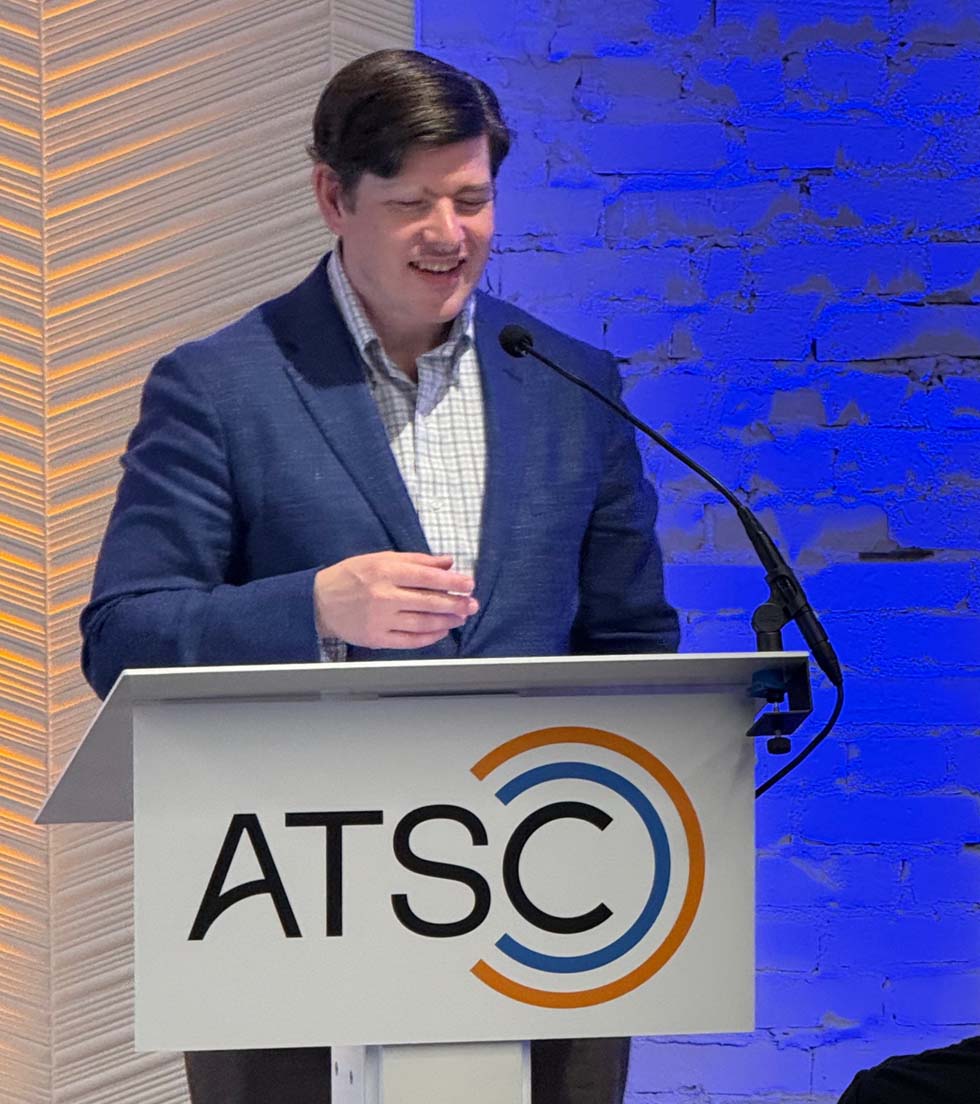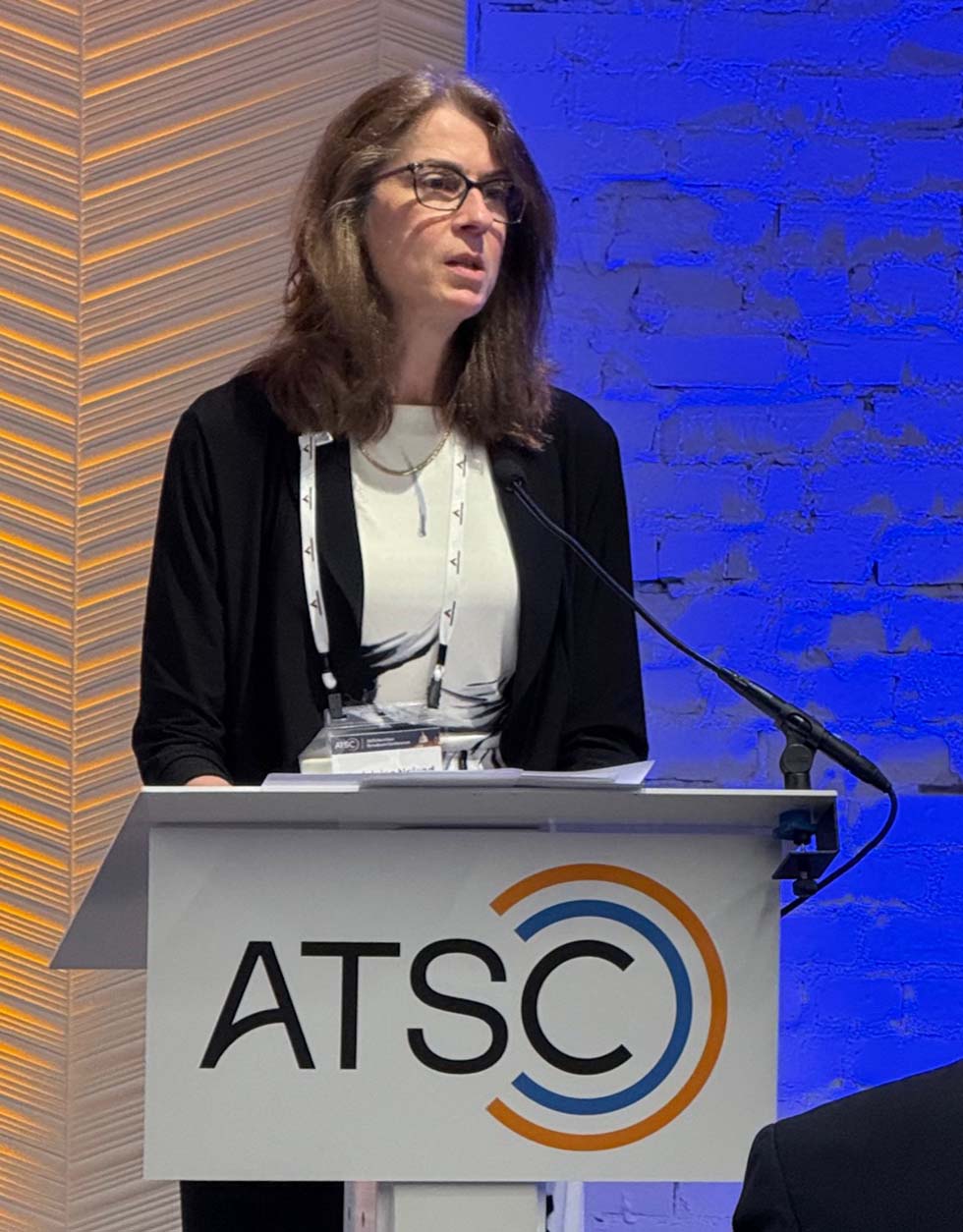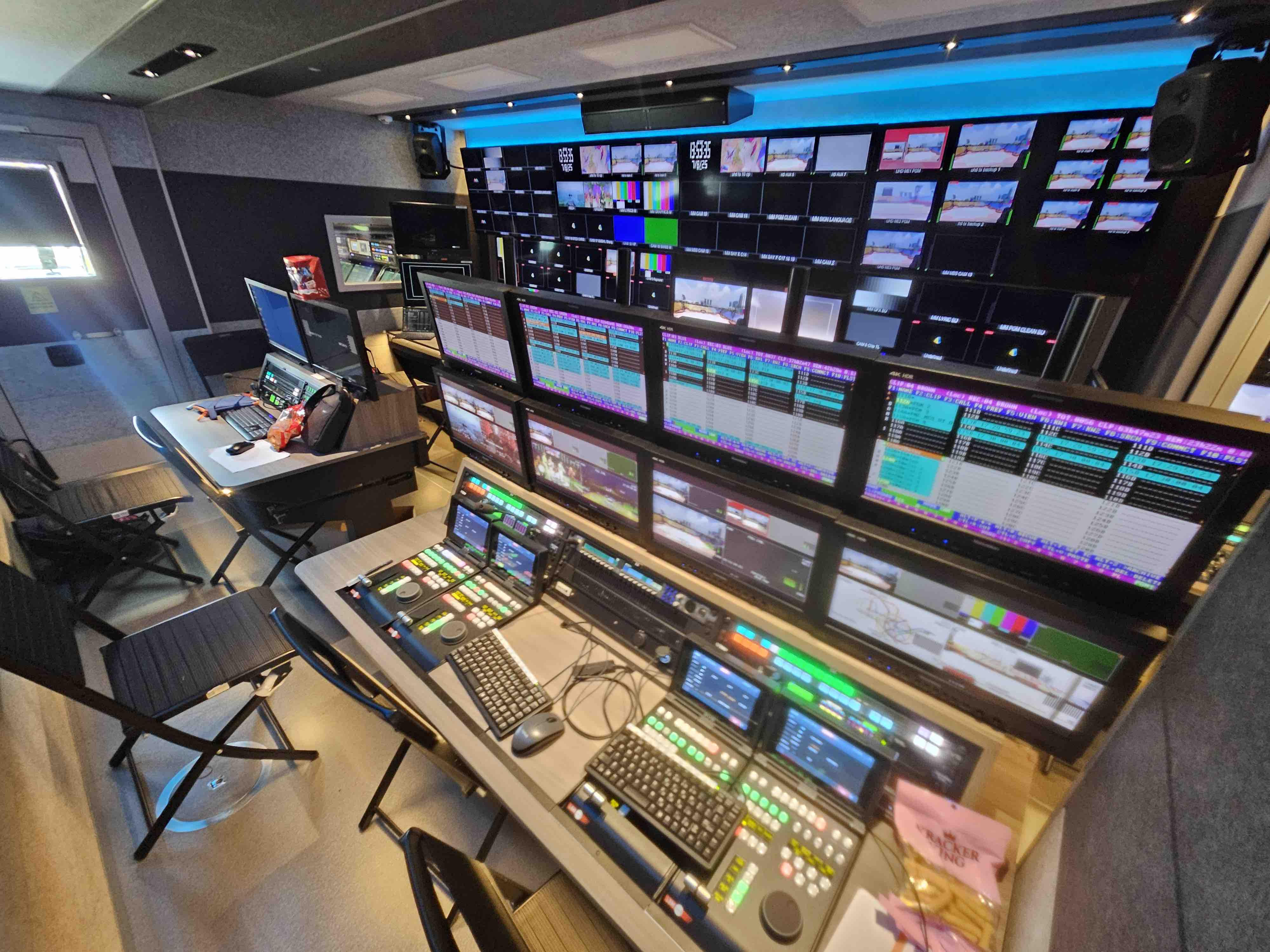1.0 Sunset, BPS and NextGen Broadcast’s Potential Dominate ATSC Meeting
Annual get-together also focused on international adoption

WASHINGTON—Sunsetting ATSC 1.0, expanding business opportunities for NextGen Broadcast and increasing international adoption of the ATSC 3.0 standard were top of mind at the ATSC’s NextGen Broadcast Conference yesterday.
The meeting here hosted representatives from numerous industries with a stake in advancing ATSC 3.0 (aka NextGen TV). With the Future of TV initiative in the rearview mirror and the National Association of Broadcasters’ petition to the Federal Communications Commission to end ATSC 1.0 by 2030, there was no shortage of topics for debate.
‘A Little More Candid’
The conference was keynoted by former FCC Commissioner Nathan Simington, who resigned his position last week. Simington prefaced his remarks by noting that he could now “be a little bit more candid than I was able to be when I was sitting on the commission.”
He opened by lambasting broadcast critics who claim that its technology has had its heyday.
“The idea that we can scrap the broadcasting sector is so wrongheaded and misguided that it shocks me that anyone has ever taken that idea seriously,” Simington said, adding that the industry has “never been more threatened than they are today,” and that if certain actions are not taken soon, “we should expect to start seeing bankruptcies and disaffiliations.”
Among such proposals is quicker response from the FCC when determining host stations in markets launching NexGen TV, he said. “I think the FCC could issue guidance tomorrow that ATSC 3.0 hosting evaluations must be done in under 30 days, and every day that they don’t do that, it strikes me that that’s a conscious choice not to take that step.”
He called for quick action on establishing a date certain to sunset ATSC 1.0 by 2028 for the top 55 markets and by 2030 for the remaining DMAs.
The professional video industry's #1 source for news, trends and product and tech information. Sign up below.
“The FCC should definitely start a process for getting the date certain to sunset DTV, that’s simply nonnegotiable at this point,” Simington said. “The burden of running both ATSC 1.0 and 3.0 is obviously a major barrier to adoption, but just as important, it crowds out necessary spectrum for developing other services that are going to be key to the continued viability of broadcasting and to its ability, over time, to continue fulfilling the load bearing functions of local journalism and emergency alerting.”

Simington also strongly advocated the concept of datacasting over 3.0, particularly in the enterprise sector. The launch earlier this year of EdgeBeam Wireless, a joint venture between Sinclair, Nexstar Media Group, Gray Media and E.W. Scripps, is indicative of the lucrative potential of NextGen Broadcast, given broadcasters’ already installed infrastructure and national footprint.
“There’s really no option but to allow datacasting to flourish,” he said. “Fortunately, providing a consistent, interoperable backend at maximum possible geographic scale—ideally internationally—is readily achievable once regulatory barriers are removed. It would not be a heavy lift of permission, in my opinion, to just snap our fingers and make that transition start to happen, thus enabling the sales cycles and R&D investments that all of you would need to cross that threshold and make datacasting more of a paying proposition and less of an interesting side project.”
Long-term, I look at datacasting as enabling broadcasters to switch their primary source of revenue from connectivity and away from ad sales.”
Nathan Simington
Simington said datacasting could transform broadcasters’ business models, calling broadcast IP connectivity “unique and valuable.”
“Long-term, I look at datacasting as enabling broadcasters to switch their primary source of revenue from connectivity and away from ad sales,” he said. “You’ve got three legs of the stool right now; you’ve got connectivity, which is more like a toothpick than a leg; you've got ad sales; and you've got retrans. With the pressure on others, the connectivity business is the only one that has a clear engineering advantage over any plausible entrant.”
Standards Progress
Advanced Television Systems Committee President Madeleine Noland opened the conference, updating attendees on progress made over the past 12 months.
“We have a number of forward-facing projects in flight right now, including ‘B2X’ or ‘Broadcast to Everything,’ which further aligns ATSC 3.0 with 5G new radio waveforms, enabling new mobile applications,” Noland said. “We have the broadcast gateway control protocol, a system that links System Managers and broadcast gateways, adding efficiency to datacasting operations. And we’re working on carriage of Digital Radio Mondiale services over ATSC 3.0 waveforms, which opens up a whole brand new list of questions.”

Noland mused about the future of the standard: “Someone I was talking to yesterday said, wow, ATSC is just going to be delivering apps. It’s almost like going to be a host as a platform, and the fact that we’re carrying Digital Radio Mondiale over it is the tip of the iceberg.”
Noland noted that when it comes to exploring new services for 3.0, the association is “casting a wide net.”
“We're listening to partners on nearly every continent; we’re studying verticals from automotive to agriculture; we’re tracking trends in streaming and spectrum management, public safety and media convergence,” she said. “And now we’re in a position to start refining that net, to prioritize, to invest, to set the framework for our future, not by chasing every shiny object, but by placing strategic bets, informed by data, insight and collective wisdom.”
The View from Brazil and the Caribbean
Raymundo Barros, president of the SBTVD Forum (Brazil’s TV standardizations group) focused on the reasons why the country—the second most populous in the western hemisphere—adopted portions of the ATSC 3.0 standard for its next generation broadcast protocol last year, adding the protocol’s physical layer to its “DTV+” digital broadcast service. With over-the-air television viewed by an estimated 60% of that country’s households, Barros called broadcast “the most important platform in Brazil.”
“This is a once-in-a-lifetime opportunity to make broadcast digital in the way we relate with the consumers and advertising, and we have a very important footprint that we are trying to speed up as much as we can in order to deploy the services throughout the country,” he said.
Singling out YouTube as perhaps broadcasters’ biggest competitor, Barros said DTV+ can succeed. “You want to compete against YouTube; YouTube is the only company that has captured the advertising on connected TV in Brazil,” Barros said, adding that with the connectivity and applications provided by DTV+, “I think we can be a very serious competitor when you take into consideration connected TV digital ads and integration with retail media.”

Barros said the country is already testing ATSC 3.0 for advanced advertising via layered division multiplexing (LDM)—a technology that overlays multiple data streams in a common RF channel—and datacasting with Sinclair Broadcast Group.
“We are already using the pilot station in Rio de Janeiro, using LDM to segment advertising for different areas of the city,” he said. “We have some interactivity, social TV, and we are collaborating and working in close collaboration with Sinclair and other broadcasters here in the U.S. to be part of this big datacasting network.”
Dr. Claire C. Grant, vice chair of the IT-7 Caribbean Team and a founding member of the ATSC Business Advisory Council, updated attendees on the progress of 3.0 in the region, which consists of 30 countries.
Over the past several years, both Jamaica and Trinidad and Tobago have adopted the standard, with Jamaica having fired up its first 3.0 transmitter in 2022. There are currently eight 3.0 transmitters in a total network of 22 to penetrate the entire island, per government mandate, according to Grant.
Trinidad and Tobago switched on 3.0 last November and is now running a pilot station.
Grant noted the unique characteristics driving industry and business when it comes to broadcasting in the region. “Generally speaking, spectrum shortage is not an issue,” she said. “The only challenge is that there is no digital dividend to be earned in the Caribbean. There’s nobody to buy any spectrum.”
Grant said one of the main impediments for the region to go all digital is that “there are still people transmitting analog—you have to transition or not transition. If you don’t transition, you will die, because there’s nobody making analog equipment as it stands.”
Grant added that regulatory challenges to end analog are also hindering progress. “There is an eagerness for the state to get to a position of analog switchoff,” she said. “A lot of the Caribbean territories think that we should be able to make that decision now.”
Power in Numbers
In a session on new services and business models enabled by ATSC 3.0, Skip Flenniken from Sinclair Broadcast Group, representing the EdgeBeam datacasting startup, discussed the advantages of combining the resources and coverage of four of the nation’s largest broadcast station groups into one entity targeting the enterprise market.
“We looked around and decided we need to do this together, and so we created EdgeBeam, and we provisioned it with what we think are the tools required to be successful,” he said. “We created a datacasting business, not just for our four companies, but for the entire broadcast industry—so those provisions, those things we think are really required for success.”
EdgeBeam is encouraging other broadcast groups to join in otis effort, touting the power of numbers. “There are approximately 700 stations between the four broadcasters really committed to EdgeBeam, so we can credibly go into datacasting customers and say we can bring you nationwide coverage,” he said, adding that even this number is “not sufficient.”
“What we are bringing to market here is a differentiated edge network, one-to-many completely different capabilities and features than other broadcast networks,” he said, “and just like every other data-distribution platform and method that’s ever existed, demand is going to exceed supply on a permanent basis.
“We’re going to need spectrum from other broadcasters,” Flenniken added. “We really view EdgeBeam as an operating company by which we bring, actualize and create datacasting, not just for the four founders, but for the industry.”
The Promise of BPS
NAB Chief Technology Officer Sam Matheny updated attendees on the efforts the association is taking towards making BPS a reality. The Broadcast Positioning System, which provides precise timing and—with a sufficient number of stations—accurate positioning using 3.0 signals, is being touted as a “complement” and even an eventual backup to GPS.
The importance of satellite-based GPS to the nation’s economy and safety cannot be overstated, Matheny said.
“A potential GPS outage can throw the U.S. economy into free fall … but it’s not just about navigating; GPS has become an invisible utility,” he said. “Over $2 billion a year goes to operating the GPS network, and it has been adopted by everybody.”
BPS was demonstrated at the 2025 NAB Show and, after receiving accolades from a number of government officials involved in the technology who saw the demos, Matheny—who credited NAB Vice President of Advanced Technology Tariq Mondal for his role in leading research into the technology—is optimistic about its future potential.
“We’re engaging multiple agencies and their words can speak for themselves,” he said. “The key thing that they talked about is that the building blocks are already there. We’re already up and on the air and broadcasting in 3.0 [and] what we need to add is really very minimal to be able to offer BPS.”
Although the bulk of the discussions surrounded the promise of new services and business models for NextGen Broadcast, the underlying thread to most of them was the need to end ATSC 1.0 by 2030 so broadcasters can realize its full potential.
”We can’t literally do this tomorrow, but we can do it by 2028 and 2030,” Alison Martin, vice president of innovation and strategy for NAB, said. “And then once we’ve committed to it, then everything else is going to fall in place, from the consumer electronics ecosystem to the MVPDs to all of the little details that have to happen at the broadcaster side. We just have to actually commit to doing it, and no individual broadcaster can do this on their own. It's just the nature of our industry. We have to all get together, set a date and follow it.”
The day ended with the ATSC honoring Aldo Cugnini with the 2025 Lechner Award and Clarence Hau of NBCUniversal with the 2025 Mark Richer Industry Leadership Medal.
Tom has covered the broadcast technology market for the past 25 years, including three years handling member communications for the National Association of Broadcasters followed by a year as editor of Video Technology News and DTV Business executive newsletters for Phillips Publishing. In 1999 he launched digitalbroadcasting.com for internet B2B portal Verticalnet. He is also a charter member of the CTA's Academy of Digital TV Pioneers. Since 2001, he has been editor-in-chief of TV Tech (www.tvtech.com), the leading source of news and information on broadcast and related media technology and is a frequent contributor and moderator to the brand’s Tech Leadership events.

